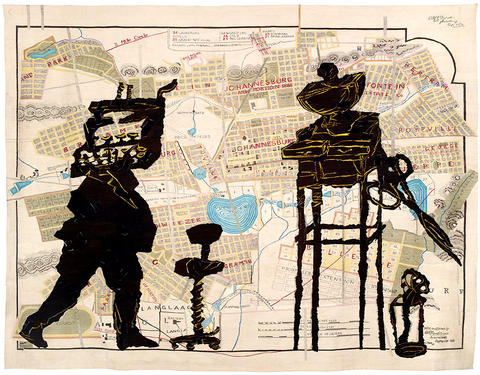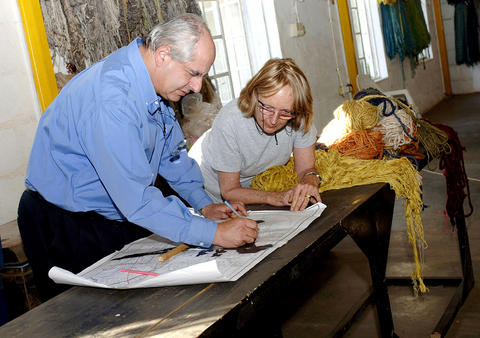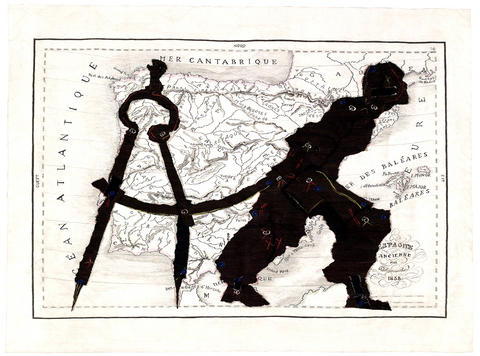An exhibition of William Kentridge's tapestries now at the Philadelphia Museum of Art may be uneven, but that's not totally surprising.
Kentridge, born in Johannesburg, South Africa, in 1955, has always tackled an immense and urgent subject: his country's anguish and inequity in the wake of apartheid. Yet he seems to lack some requisite sense of touch or engagement with the materials of art. Perhaps because he began as an actor, writer and set designer, he doesn't exhibit great feeling for the immediacy of the art object.
As a result, his work is almost always best when presented at a remove, in translation or in motion. His charcoal drawings are never as effective on the wall as they are when mutating in his powerful animated films and videos. In moving images the charcoal becomes a tool that almost literally burrows through South African history and human consciousness. Similarly, his drawings, objects, films and shadow figures can work brilliantly for the illusory magic of set design, as his imaginative staging of Mozart's Magic Flute proved recently at the Brooklyn Academy of Music.

PHOTO: NY TIMES NEWS SERVICE
William Kentridge: Tapestries clarifies this discrepancy, and even benefits from it. The collages on which these tapestries are based, along with related prints and bronze sculptures - all looking fairly inert - are in one gallery. In the other, much larger gallery are the 11 tapestries, completed since 2001, looking a lot livelier, even rather gorgeous, if not as completely alive as his films and video.
The tapestries show large, dark silhouettes - the latest incarnation of the shadow figures Kentridge has deployed for years - against the patterns of old maps. That the tapestries improve greatly upon the collages is one of the show's revelations.
The tapestries were made by the Stephens Tapestry Studio in Johannesburg, in close consultation with Kentridge. Marguerite Stephens established the studio in 1963 in Swaziland as a carpet and curtain weaving business. She moved it two years later to Johannesburg to focus on her craft's artistic potential. According to the exhibition catalog, the weavers use the French Gobelin high-warp technique, working from the bottom up on a vertical loom with the cartoon of the weaving behind it.

PHOTO: NY TIMES NEWS SERVICE
You don't need to know all this to be impressed by these works, which tap into a long, glorious history and take full advantage of tapestry's capacities for intricacy, color and scale.
Ten are from Kentridge's Porter Series. Measuring as much as 3.6m high or wide, they show one or two figures carrying, or oddly fused with, objects. Of indefinite race, age and often gender, the porters have a Michelangelesque grandeur, even as their black-brown tonality suggests tar or earth. Contributing to their imposing stature are their backgrounds: maps from a world atlas published in 19th-century Europe, when its empires were the most expansive.
In the Puppet Drawings collages on which these tapestries are based, the porters are made from pieces of thick, seemingly torn dark paper hinged together with small, circular pins. As with puppets, their limbs appear moveable.

PHOTO: NY TIMES NEWS SERVICE
True to their name, the porters are moving stuff. They are nomads, refugees, asylum seekers or maybe even adventurers. They seem more industrious than driven, but mostly they are on the move, set in motion by forces beyond their control. They are universal, but you could locate them at any point on the maps, and they would become specific, displaced by this or that invasion, liberation, revolution, colonialism or economic crisis.
As characters they range from the symbolic to the real and back again. Rushing across Germany, the Pylon Lady has legs that suggest a draftsman's compass. The figure marching across Central America is piled with ladders and tools that might belong to a gardener or carpenter. Asia Minor is being traversed by a man who has sprouted tree limbs.
The 11th tapestry, Office Love, is the largest - around 3.6m by 4.6m - and easily the most beautiful. Its protagonists include a heavyset businessman with a typewriter for a head, who purposefully approaches three more or less feminine pieces of office furniture, the largest of which is a scribe's table that seems to hold a pair of scissors. Something is in the air. Maybe it is sexual tension; maybe it is simply progress. The writing machine is invading the scriptorium. Interestingly, typewriters started to become standardized in the 1890s, as modern Johannesburg was first being built.
Translating the collages into tapestries is a process of amplification, expansion and refinement. They are redrawn and further detailed in thread. Lines of red, yellow and blue, muted in the collages, become brighter. New lines are added, too, giving the works a greater sense of flux, as if Kentridge were rethinking them. The maps become more legible, the edges of the torn paper more assertive. In awakening and giving life to Kentridge's images, the weaving process could almost be said to animate the collages, to give them a visual energy bordering on motion.
In his catalog essay, Carlos Basualdo, the Philadelphia Museum's curator of contemporary art and the organizer of this exhibition, uses the term "generic creativity." To my mind, generic is a pejorative that implies something is routine, general and impersonal. It is exactly the term I would use to describe what's wrong with many of Kentridge's art objects. I would also suggest that as Kentridge's work moves further away from the specific travails of South Africa, as it does here, it becomes more generic.
But Basualdo translates generic differently, more positively, and arrives at a fresh and helpful point of view. He uses the phrase to describe how weaving transforms Kentridge's ideas by reinterpreting them through a human activity that is not attached to an individual creator, but is instead a "generic creativity" that can be expressed by anyone, in this case, trained in and attentive to the craft.
That's a big idea. It makes sense, given Kentridge's roots in the collaborative art of theater. And it underscores why the work from his own hand gains immeasurably when filtered through a second process, whether provided by a weaver or a video camera. In keeping with the themes of his best efforts, his art is subjected to a form of liberation.

On April 26, The Lancet published a letter from two doctors at Taichung-based China Medical University Hospital (CMUH) warning that “Taiwan’s Health Care System is on the Brink of Collapse.” The authors said that “Years of policy inaction and mismanagement of resources have led to the National Health Insurance system operating under unsustainable conditions.” The pushback was immediate. Errors in the paper were quickly identified and publicized, to discredit the authors (the hospital apologized). CNA reported that CMUH said the letter described Taiwan in 2021 as having 62 nurses per 10,000 people, when the correct number was 78 nurses per 10,000

As we live longer, our risk of cognitive impairment is increasing. How can we delay the onset of symptoms? Do we have to give up every indulgence or can small changes make a difference? We asked neurologists for tips on how to keep our brains healthy for life. TAKE CARE OF YOUR HEALTH “All of the sensible things that apply to bodily health apply to brain health,” says Suzanne O’Sullivan, a consultant in neurology at the National Hospital for Neurology and Neurosurgery in London, and the author of The Age of Diagnosis. “When you’re 20, you can get away with absolute

May 5 to May 11 What started out as friction between Taiwanese students at Taichung First High School and a Japanese head cook escalated dramatically over the first two weeks of May 1927. It began on April 30 when the cook’s wife knew that lotus starch used in that night’s dinner had rat feces in it, but failed to inform staff until the meal was already prepared. The students believed that her silence was intentional, and filed a complaint. The school’s Japanese administrators sided with the cook’s family, dismissing the students as troublemakers and clamping down on their freedoms — with

As Donald Trump’s executive order in March led to the shuttering of Voice of America (VOA) — the global broadcaster whose roots date back to the fight against Nazi propaganda — he quickly attracted support from figures not used to aligning themselves with any US administration. Trump had ordered the US Agency for Global Media, the federal agency that funds VOA and other groups promoting independent journalism overseas, to be “eliminated to the maximum extent consistent with applicable law.” The decision suddenly halted programming in 49 languages to more than 425 million people. In Moscow, Margarita Simonyan, the hardline editor-in-chief of the